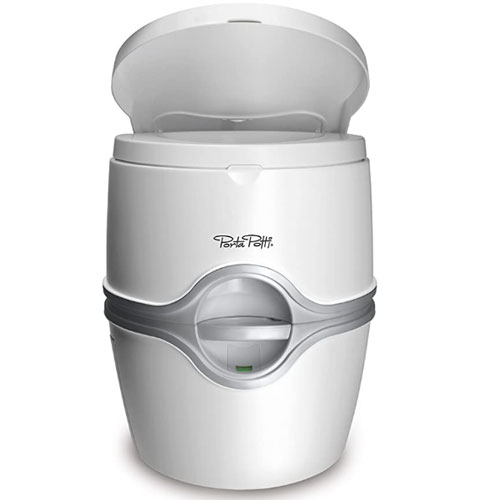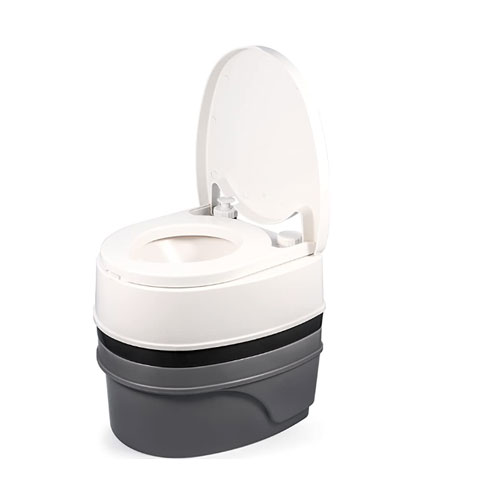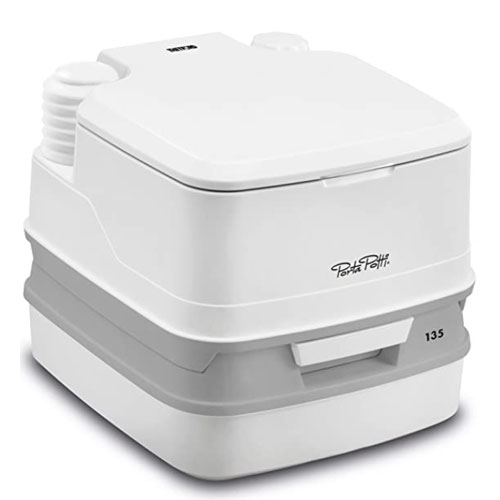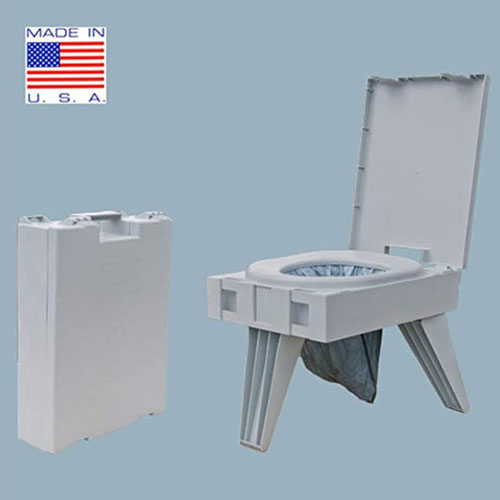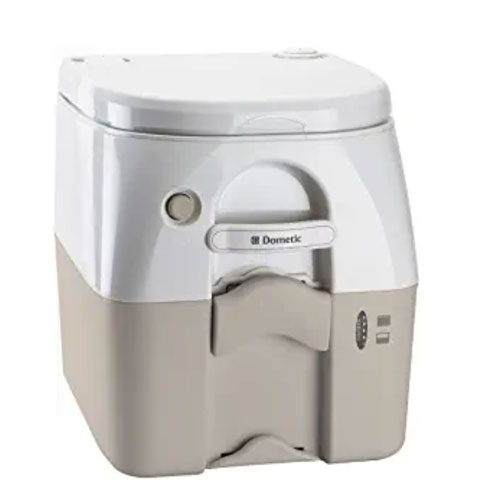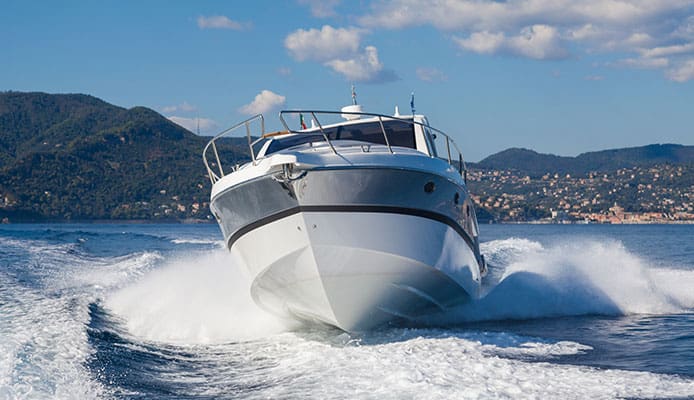
-
1.
-
2.
-
3.
-
4.
-
5.
If you enjoy going on multi-day boat trips, having a proper toilet on-board necessary. While marine toilets are not the same as the one you have at home, they can still offer a very high level of functionality and comfort.
As you maybe know, several different types of marine toilets exist – portable cassette models, pump-outs (manual and electric), and even eco-friendly composting toilets. In this article, we picked out the best marine toilets from each type so you can have all the comfort and commodity you need when nature calls.
Best Cassette Type Marine Toilet
Porta Potti 565E White Thetford
- Stand Out Features - Why We Love It
- Increased seat height and bowl size for additional comfort
- Large waste container so you don’t have to empty it frequently
- Battery-powered flush makes use more convenient
- Stylish design fits great on any type of boat
- Optional hold down kit for securing the toilet to the floor
Type: Cassette
Dimensions: 18.39 x 15.75 x 17.83 inches
Fresh Water: 4 gallons (50+ flushes)
Waste Tank: 5.5 gallons
Weight: 13.45 pounds (empty)
Best Marine Toilet For Any Interior Design
Thetford 92860 Porta Potti
- Stand Out Features - Why We Love It
- Modern design blends in nicely in the boat interior
- Rotating pour-out spout for emptying the cassette
- Compact and lightweight for moving around
- Ergonomic carrying handle makes carrying easier
- Excellent price considering the quality you get
Type: Cassette
Dimensions: 12.2 x 13.5 x 15 inches
Fresh Water: 2.6 gallons (27 flushes)
Waste Tank: 2.6 gallons
Weight: 8 pounds
Best Compact Marine Toilet
Cleanwaste Portable Waste Kit
- Stand Out Features - Why We Love It
- Most compact option if you need to save space
- Works with waste kits that you tie off and throw away
- One waste-bag kit included in the package
- Foldable legs are very strong and stable
- Excellent weight capacity for heavy users (500 pounds)
Type: Waste Kit
Dimensions: 19 x 4 x 15 inches
Weight: 7 pounds
Best Eco-Friendly Marine Toilet
Nature’s Head Self Contained Composting
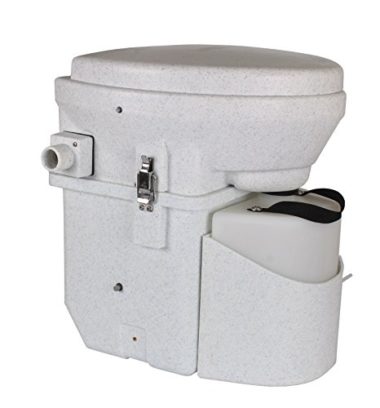
- Stand Out Features - Why We Love It
- Fully self-contained composting design
- Most eco-friendly option that you can get
- Full-size elongated seat for improved comfort
- Rugged marine design with stainless steel hardware
- Vent hose and fan included in the package
Type: Composting
Dimensions: 22 x 20.5 x 21.7 inches
Power Source: 12V
Weight: 28 pounds
Best Comfortable Marine Toilet
Dometic 970 Series Portable
- Stand Out Features - Why We Love It
- Hold-down brackets for permanent installation
- Single-button flush makes clearing the bowl easy
- Latching lid for closing the toilet securely when not in use
- ABS plastic construction ensures durability
- Scratch-resistant tan and white matte finish
Type: Cassette
Dimensions: 15. 25 x 15. 25 x 13. 125 inches
Fresh Water: 5 gallons
Waste Tank: 5 gallons
Weight: 13.1 pounds
Best Manual Pump-Out Marine Toilet
Dometic SeaLand Traveler 510
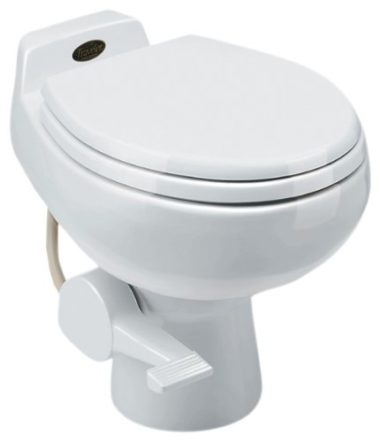
- Stand Out Features - Why We Love It
- Flushes with only a pint of water from the water system
- Integrated anti-siphon system protects the clean water supply
- Self-cleaning flush ball with seal blocks tank odors
- User-friendly and efficient rim flush action
- Household-sized seat provides exceptional comfort
Type: Manual Pump-Out
Dimensions: 25.9 x 25 x 20 inches
Weight: 20 pounds
Best Manual Head Marine Toilet
Jabsco Twist ‘n’ Lock Manual Head
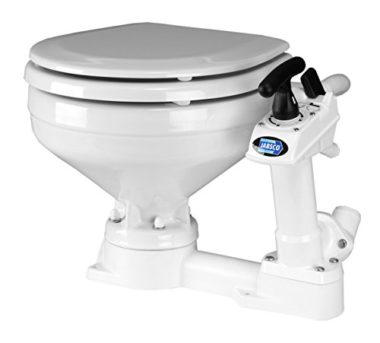
- Stand Out Features - Why We Love It
- Twist’n’Lock handle protects against waste backflow
- Premium feel of the white vitreous china bowl
- Equipped with a luxurious wooden seat
- Powerful self-priming pump for efficient pumping
- Crevice-free design makes cleaning easier
Type: Manual Pump-Out
Dimensions: 17.7 x 17.7 x 13.2 inches
Weight: 30 pounds
Best Electric Marine Toilet
Johnson Pumps Aqua Toilet Compact
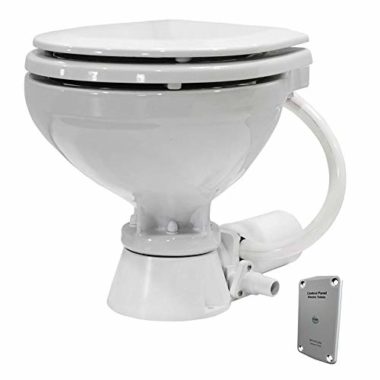
- Stand Out Features - Why We Love It
- Electric flushing system (12V) makes the use incredibly easy
- Powerful combined pump for reliable disposal and flushing
- All hardware is completely corrosion-resistant
- White vitreous porcelain looks fantastic
- Much quieter in operation compared to manual models
Type: Electric Pump-Out
Dimensions: 19 x 17 x 16 inches
Power Source: 12V
Weight: 25.5 pounds
Best Ergonomically Designed Marine Toilet
Johnson Pumps Aqua Compact Manual
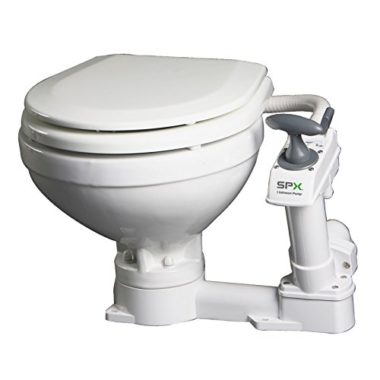
- Stand Out Features - Why We Love It
- Compact design fits in tighter spaces on-board
- Ergonomic seat feels nice to sit on and use
- Completely resistant to saltwater and corrosion
- Hand-powered piston pump mounts on either side
- High-quality porcelain finish is very easy to clean
Type: Manual Pump-Out
Dimensions: 17 x 17 x 20 inches
Weight: 26 pounds
How To Choose A Marine Toilet – Buying Guide
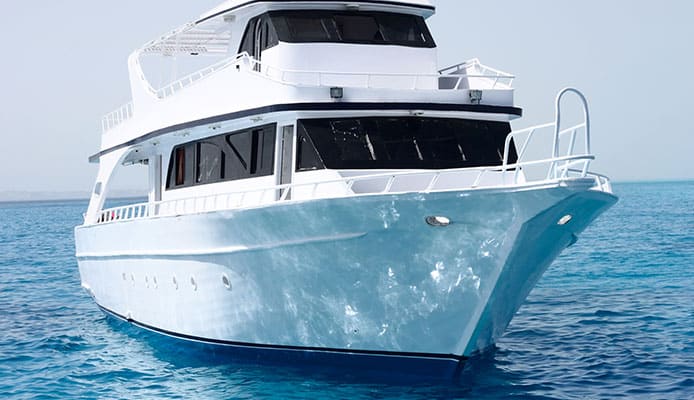
Type Of Toilet
Different types of toilets can be installed on-board, but they all have some pros and cons that you should be aware of. The price range varies, as well as the comfort they offer.
Cassette toilets: This is the same type of toilet people use in their RVs. It can be completely portable, or you can have a toilet permanently installed, with a cassette to hold the waste.
Completely portable potties are particularly useful for tight spaces because they can be placed in a corner. A cassette holds everything in until you reach a site where you can dump it in a sewage line on land.
While this sounds practical, it comes with a few downsides. You are going to have to carry the cassette from the toilet to the sewage yourself, and it can be very heavy.
Another downside is the smell when disposing of the waste, which is not quite pleasant. After you’ve emptied it, you’ll have to rinse it before putting it back into place, meaning that the whole process requires effort on your part.
Pump-out toilets: These are usually a better long-term solution. Some boats will come with this type of toilet pre-installed, or have piping and a holding tank in place so you can do this yourself.
Two types of pump-out models are available – manual and electric. On a manual toilet, you flush by pulling and pushing the lever on the side, and it usually takes 10-15 pulls to get it through the system.
On the other hand, electric marine toilets do this by themselves, because they have an electric pump (like the TMC electric marine toilet, for example). This is a great solution because it eliminates manual marine toilet operation but, on the other hand, it needs to be connected to a power source.
Composting toilets: This type of toilet is the most eco-friendly option compared to others. It doesn’t use water, but rather separates the liquids from solids.
The urine goes into a separate tank which you have to empty, while the solids go in a special composting chamber. There they are mixed with sawdust, peat moss, or other organic substance which helps it dry out.
This completely degrades the waste, making it safe to dispose of, and making a good plant fertilizer. Composting toilets are similar to portable potties, meaning they don’t require any particular installation.
They are, however, usually larger (and taller) than typical marine toilets, so keep this in mind when measuring the space where you want to install the toilet.
While it depends on the model and manufacturer, composting chambers are usually large enough to be used by two people for up to 30 days. It’s a toilet with low maintenance, no chemicals, and no risk of clogging.
Eco-Friendliness
This is becoming a larger concern in recent years, and rightfully so. There are specific rules and regulations about how you are allowed to dispose of the sewage on your boat.
First and foremost, you aren’t allowed to dump your untreated waste in the water. There are special on-shore facilities that have pumps to empty your holding tank. If you’re using a cassette toilet, you must empty it when you come to land.
Be mindful of the chemicals you use for disinfection and odor-neutralization for your toilet because some can be very harmful. This is particularly important if you are on a large vessel that has a treatment system and releases the wastewater in the sea.
Also, it’s recommended to always use bio-degradable paper, as this is good for both the environment and the piping on your boat (less likely to get clogged).
Finally, the most eco-friendly solution is a composting toilet on boat. If you want to try something new and in-line with nature, we certainly recommend trying it out.
Materials And Construction
Because of the harsher conditions a marine head must endure, it’s also logical to make it from tougher materials. It can be exposed to saltwater and other unfavorable factors.
For this reason, all hardware should be made from stainless steel to avoid corrosion. As you’ve seen, toilets are either made from high-quality plastic (polyethylene) or they are made from porcelain, much like your toilet bowl at home.
Portable toilets for boats are usually plastic. This is for practical reasons because it weighs less than a porcelain bowl, and it’s also more sturdy and damage-resistant. On the other hand, plastic can sometimes be harder to clean and requires bleach or odor neutralizers to eliminate the smell.
Porcelain toilets are heavier and need to be installed like a regular toilet. You’ll need to screw it down and connect it to the holding tank. They look much better and feel nicer to use. Often they will have a standard-sized seat made of wood, which increases comfort. They are cleaned more easily, which is a plus.
Footprint And Hooking
Boats usually have a designated space for your toilet, and the size can be limited. The measurements of your new head should match those from the old one, or at least be close to them.
This way, you can be sure you can install it properly even if you need to drill a few more holes. However, be careful when drilling new holes – you can go too far and damage something by accident.
If you choose a classic portable potty, you won’t need to connect it to anything. However, with more sophisticated solutions, you’ll need to connect them to a fresh water source (for flushing) and to the piping system that leads to the holding tank.
You might also like: Top Marine Power Inverters
Smell
One of the biggest concerns when shopping for a new toilet is the odor issue. It’s very unpleasant to have odors spreading around until you empty the cassette (waste container) or the boat holding tank. For this reason, toilets should have valves that seal off the tank and prevent the smell from spreading.
To additionally help remove it, special deodorizers are either added to the flushing water or put in the holding tank. Boat’s old piping system can also be the cause of an unpleasant smell, so be sure to look into that too when installing the new toilet.
The biggest issue can come from portable toilets that are not sealed off properly or aren’t well-made and start leaking. This is why it’s better to spend some time researching and even give a bit more money to get a reliable product.
A solution which eliminates all smells are composting toilets because the solids are going to be mixed and dried out instead of left in a tank.
Noise
Because of pumps and flushing systems, marine heads can be pretty loud. This can be inconvenient in many situations. For example, your guests can feel unpleasant when they need to flush because everyone on board hears it.
Also, sometimes you need to go in the middle of the night while other people are sleeping. Using a loud pump-out toilet can wake everybody up.
This is worth mentioning because it can be an issue for some people. If this is the case, modern heads are designed in such a way to minimize noise, but they are not all the same. With this in mind, it’s not a bad idea to go through some user experiences and see how happy they were with it.
FAQs
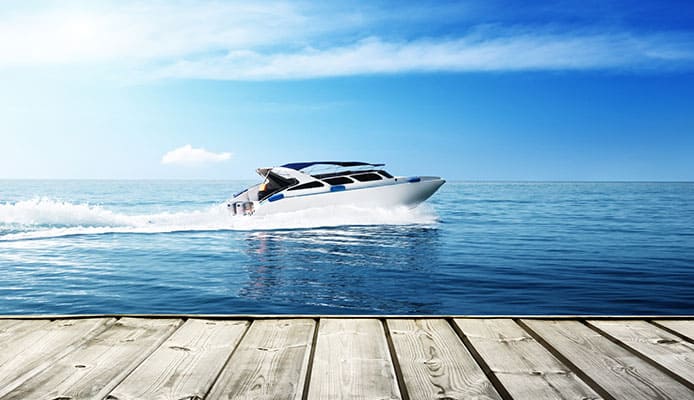
Q: What Is A Marine Toilet?
While this largely depends on the type of toilet you have, most marine toilets don’t require a lot of water for flushing. For example, Porta Potti 565E we’ve featured can flush up to 50 times with only 4 gallons of water.
On the other hand, pump-out toilets that are connected to the boat's water supply often require about ½ a gallon per flush.
Q: Why Do I Need A Marine Toilet?
Traditional pump-out toilets have a pump system (manual or electric) that pushes the waste and cleans the bowl. When you pump the handle, waste from the bowl gets sucked towards the tank (usually below the waterline), while clean water simultaneously flows into the bowl.
Q: How To Install A Marine Toilet?
Most modern marine toilets are flushed, just like those we have at home. However, the system might be different depending on the type of toilet you have.
On a pump-out toilet, the pump system uses the boat’s water supply (fresh or saltwater) to push the waste into the tank. As for cassette toilets, the built-in fresh water tank releases the water to flush the waste into the cassette.
Q: Why Are Marine Toilets Called Heads?
The origin of the name goes a few hundred years back, to the time of sailing ships. In those days, toilets were always located at the bow of the ship, otherwise known as the head.
This was done for practical reasons because on sailing ships the wind never blew directly to the front. While toilets (or heads) can be placed pretty much anywhere these days, the name still stuck.
Q: How Do Boats Get Rid Of Human Waste?
If your boat has a storage tank on-board, you should only empty it at dump stations on shore. These stations take the waste and treat it, so it isn’t harmful to the environment.
On the flip side, if you have a cassette toilet for a boat, you can empty the cassette in a standard restroom if you don’t have a dump station nearby.
Globo Surf Overview
Whether you want a compact toilet that you can store out of sight or something full-sized and more comfortable, carefully picking a boat toilet will make your time on-board much more enjoyable.
With the help of our reviews and guide, we hope that you’ll have an easy time selecting the best marine toilet and make using the restroom on your boat a bit less unpleasant.



